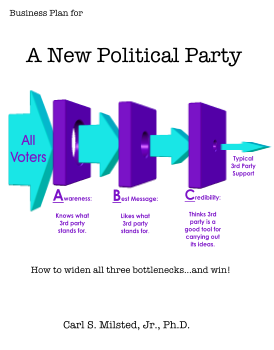Awareness, a Closer Look:
ďItís not the platform! We just have to get the word out!Ē Such was the response I often received at the 2006 LP Convention when I and the other members of the Libertarian Reform Caucus tried to move the LP closer to the center. This contention is demonstrably false.
So press coverage is weak, advertising budgets are small, etc. It doesnít matter. The Libertarian Party has been around for 35 years. During that time party members have talked to friends, family and other contacts. An increasing number of people have been made aware of the partyís existence and its general ideals. The process is deterministic. Even with zero party growth, we should expect at least a linear increase in party awareness due to the ongoing efforts of existing party members.
No advertising budget is necessary!
If awareness was the growth limiting factor, then the party should be growing. Awareness is deterministic and cumulative. People donít forget what a party stands for once they learn. The LP (and other third parties) have motor-mouths who make it their mission to inform others.
For a new party, awareness is a bigger problem. This is also true for an existing party that changes its message. If the Libertarian or Green parties were to moderate their messages, it would take a significant marketing campaign in order to convince people this has happened. In fact, marketing a new and improved message for a party that has been excessively radical for decades is more expensive than marketing a new party. Such extra effort might still be worthwhile because the existing party has a donor/activist base, however.
All this said, there is room for growth in awareness by the various third parties. Most people donít listen that carefully to either political ads or to individual blow-hards. We can measure how wide the awareness bottleneck is by asking polling questions such as:
-
Who was the Libertarian Party candidate in 2004?
-
Who was the Green Party candidate in 2004?
-
Which parties call for legal marijuana?
-
Which parties stand for bringing our troops home from Iraq?
-
Which parties call for socialized medicine?
-
Ö
In doing such a poll I would include answers relevant to several parties, including the major parties in order to get objective answers. Actually, answers regarding major party candidates/positions can provide a valuable baseline to determine the norm for awareness. Some people just arenít interested in politics.
Even if such polling shows a large gap in awareness between the major parties and your third party, I still would question the wisdom of putting too much resources into an awareness campaign. I would look at the other two bottlenecks first.
B. If people donít like your message, they wonít listen to all of it. And they are likely to forget what they did listen to.
C. If people think you are a loser for supporting a fringe party, they are much less likely to listen to you. This especially holds for the press. You will get little free coverage without having some credibility.
Previous
| 1
| 2
| 3
| 4 | 5
| 6
| 7
| 8
| 9
| 10
| Next
Copyright 2007, Carl S. Milsted, Jr. All rights reserved.
|






